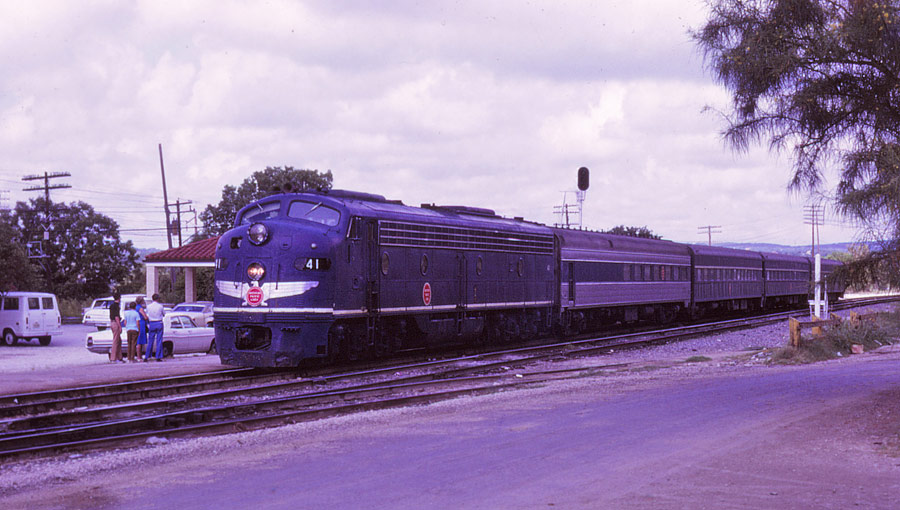

Having worked as a youthful telegrapher for the Cotton Belt and L&A railroads in the early 1950's, I was displaced by CTC, but maintained an interest in railroading. I managed to stay in contact with railroad employees with whom I had worked, and took up rail photography as a hobby. The idea came to me that perhaps the railroad would like to document the final passenger run in Texas. Somewhat uncertain about the chances, especially since train discontinuances were usually surrounded with secrecy, I contacted a person in the Public Relations Department of the Missouri Pacific in St. Louis by letter, aided by a phone call from an official in Longview.
I also proposed to submit an article to the Longview Morning Journal, with photographs, for publication in a daily issue, while promising not to place the railroad in an unfavorable light. After a couple of weeks, I received a positive response along with a "photographer's release" form which had to be notarized and returned to St. Louis. The letter that accompanied the release requested my work and home telephone numbers, and mentioned that the last run could come on a relatively short notice. The railroad would make every effort to contact me with as much advance notice as possible.
The approved release was returned to me about two weeks later. The prohibition against riding on locomotives and cars had been waived. All that remained was to wait for the phone call. In the meantime, I made plans, decided which type camera and film to use, and persuaded a co-worker and fellow rail photographer at Texas Eastman to make the trip. It was surprising how responsive the railroad had been to my request.
Several months passed. On a Monday afternoon in September 1970, I left my office and went into an operating area of our plant. Upon returning, there was a call-back note on my desk that read something like "tonight is last run for No. 2" and left a telephone number in St. Louis. It was about 3:00 PM when the call came from St. Louis. No. 2 was due out of Palestine at 7:20 PM. I returned the call and was given the specifics, along with a request not to publicize the run in advance. A short while later, a call came from the Superintendent's office in Palestine giving the same information, and advising me to meet the outbound crew at the register room in the depot at Palestine.
Ray Sheridan, MP Road Foreman of Engines (RFE), was riding westbound No. 61 between Marshall and Longview en route to Ft. Worth, when he received a radio message to leave No. 61 at Longview and instead ride No. 267 to Palestine. No reason was given, but he was also instructed to ride No. 2 from Palestine to Texarkana that evening.
My friend Donald Ormes, a fire protection specialist, and I left Texas Eastman about 5 PM driving to Palestine. The trip only required a little over an hour. Upon arriving Palestine I located conductor Tony Dressel and the brakeman. [J.D. Dean was the Porter/Flagman out of Palestine.] Engineer Kelly Steele and fireman Fred Hickman arrived shortly afterwards. The crew signed the register, read orders, and compared watches. In the meantime No. 2 arrived from Hearne, running about an hour late.
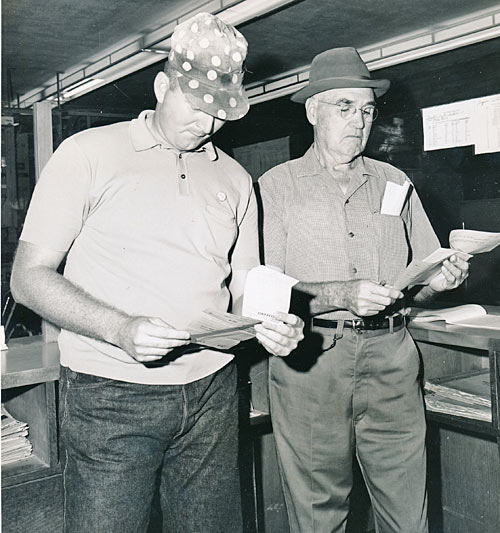
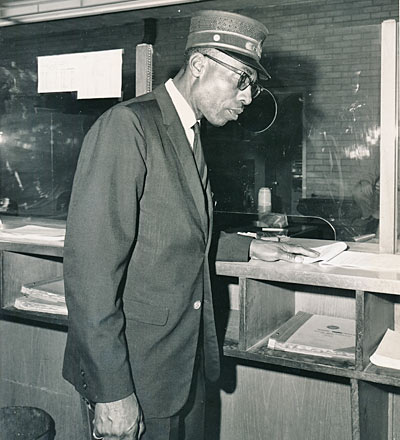
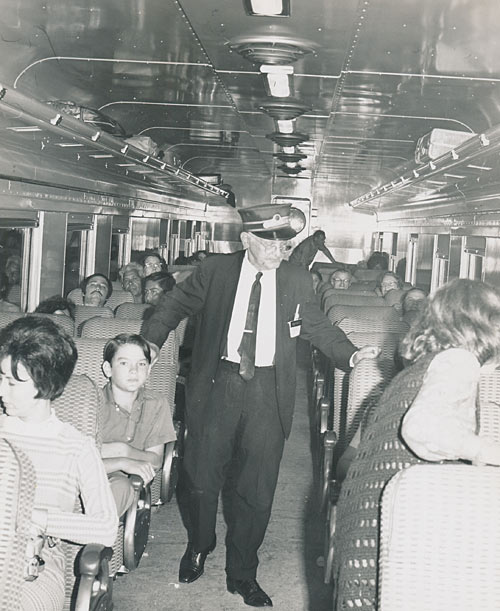
I walked next door to the passenger waiting room and purchased the last ticket sold at Palestine, two one-way fares from Palestine to Longview. It was my intention to keep the stub as a souvenir. I handed the ticket to Don to use to board the train. The conductor said the trip was on him, so the ticket and stub remain intact.
As Don boarded the train, I boarded the cab of C&EI engine 43 a minute or two prior to departure. The cab of this E-8A passenger locomotive had only three seats, so it was necessary for the RFE to stand beside the engineer for the Palestine to Jacksonville leg of the trip, leaving the seats for the engineer, fireman and myself. Before leaving Palestine, Mr. Sheridan guided me back to the engine compartment and permitted me to photograph the engine room and steam generator. Our train consisted of one engine and two passenger cars, a diner-lounge(1) and a coach. The speed limit was 60 MPH. The RFE instructed me to repeat block signals along with others in cab. Engineer Steele kept the cab interior lights on for a few miles in order for me to take photographs, and be photographed while the train was moving.
At Jacksonville, there was a brief one minute or so stop which just barely gave me time to walk from the engine to the coach. About seven or eight of the conductors great grand children, accompanied by an adult, had ridden the train from Palestine to Jacksonville. Don had already taken pictures in the coach and diner-lounge, and a ham sandwich and coke were waiting for me in the diner-lounge. The dining car crew of two men were very courteous. Both were employees with many years of service. I learned that one had offered to walk through the lounge car and engine compartment of the locomotive, while moving, to deliver the meal to me. Don thanked him, but advised I would be joining them in the diner-lounge at Jacksonville. On this final trip, diner-coach 580 was in service, with a two-man crew; waiter-in-charge R.E. Murphy and chef/attendant Roy Taylor.
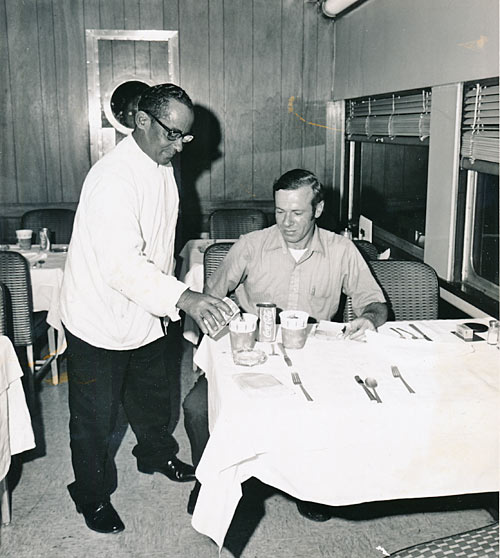
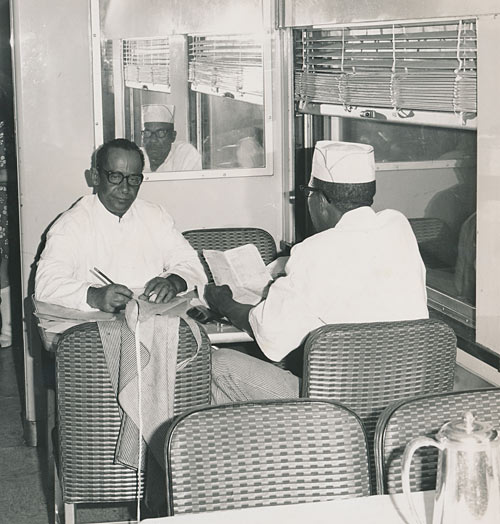
Waiter-in-charge R.E. Murphy serves Charles Harris after his cab ride from Palestine to Jacksonville. The absence of china is icurious, and suggests that the diner had closed for the evening, with the sandwiches and drinks provided as a courtesy. In the second view, R.E. Murphy and Roy Taylor finish up their paperwork, no doubt contemplating their future as the last No. 2 in Texas rolls north.
The next stops were Troup and Kilgore where there was little passenger activity, and we departed after brief stops. I do not recall meeting any trains between Palestine and Longview. At Longview, we pulled into track Passenger 2, which was located next to the station. This track provided access to the train without having to go through the tunnel as would have been the case on Passenger 1, or the main track. There was only a scattering of passengers ready to board the train. The office personnel had come out on the platform to take a last look at the train. A new crew boarded the train for the run to Texarkana. The departure of No. 2 from Longview closed out 101 years of passenger train service. Both Conductor Dressel and Engineer Steele retired after the final run. The crew on the final T&P run from Longview to Texarkana was made up of conductor J. K. Welsh, brakeman C. F. Adams, engineer J. K. Musselwhite, and fireman C. E. Palmer.
In 1957 there had been fourteen passenger trains each day between Longview and Marshall; ten between Longview and Fort Worth, and six between Longview and Palestine. During WWII the "Sunshine Special", predecessor of the "Texas Eagle", was run in two sections out of Texarkana, one each for Houston and Laredo. No. 15, the mail train, also frequently ran in two sections to Ft. Worth, and continued to run in sections as late as 1948. Texas Eagle passenger train service was inaugurated in August 1948. From that level of activity in 1948 to the end of all passenger service 22 years later is something that few would have predicted.
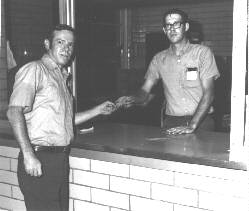
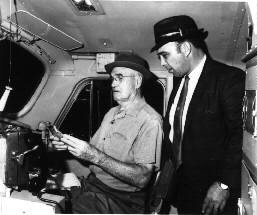
Locomotive Engineer Kelly Steele and Road Foreman Ray Sheridan check the train orders before leaving.
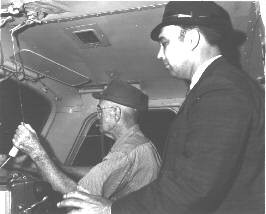
The Eagle's whistle echoes through the East Texas darkness for the last time.
B&W photos by Chuck Harris
.
.
.
.
.
.
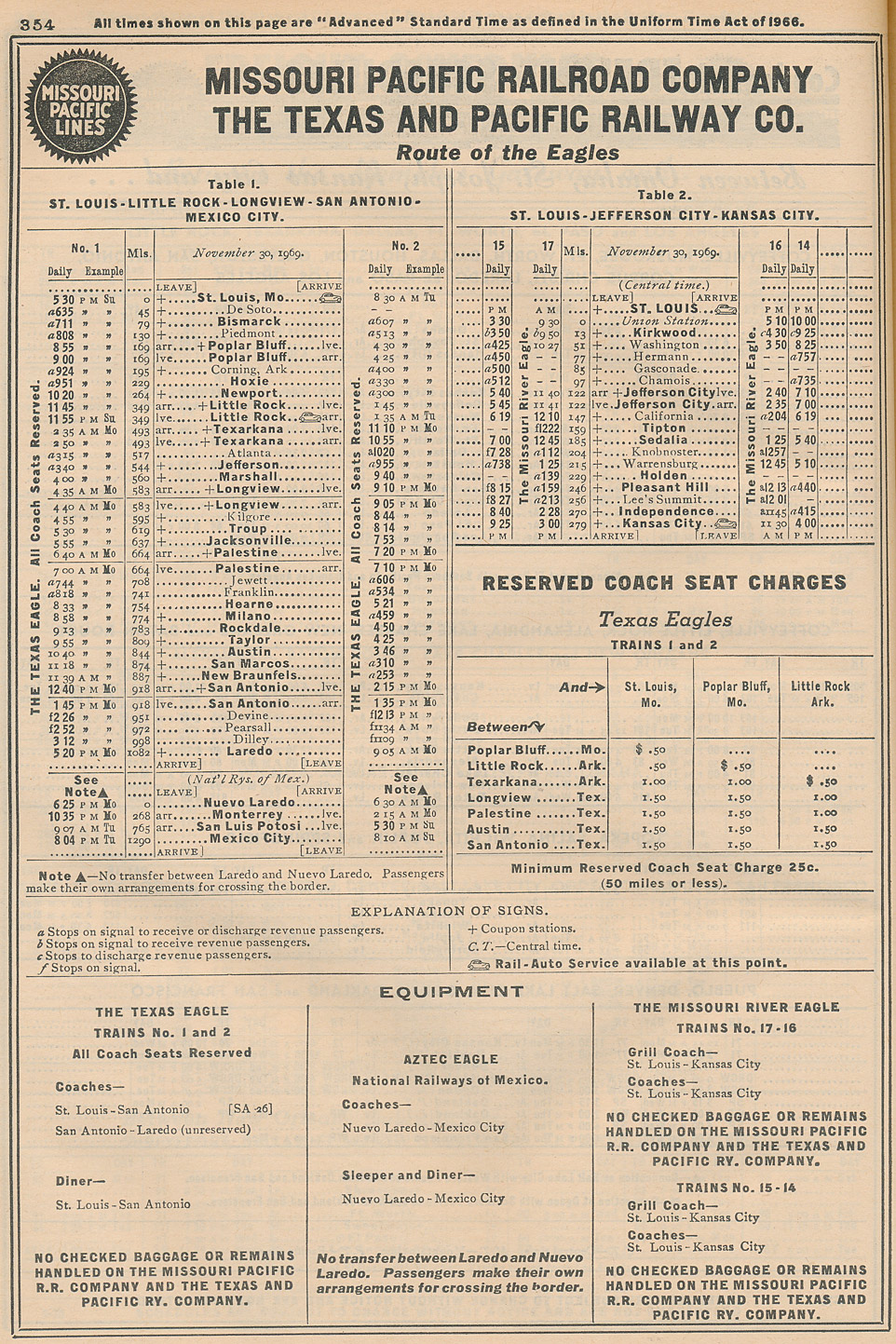
NOTE 1. The original manuscript by Chuck Harris refers to diner-lounge cars, and indeed Missouri Pacific had several cars of this configuration in prior years. By 1970, however, all diner-lounge cars had been retired, and diner-coaches 580-582 were the standard food service cars assigned to the Texas Eagle. 580-581 were former Texas Eagle diners 841 and 842, built by AC&F in 1948 and wearing the full blue paint scheme. 582 was former Colorado Eagle diner 847, built by Budd in 1940 and wearing a stainless exterior and blue window stripe. These cars had been modified by MP's Sedalia, Missouri passenger car shops in late 1962-early 1963 with the addition of 32 coach seats in one end of the car while retaining a full-size kitchen and table seating capacity for 24.
Another perspective on the last run of the Texas Eagle can be found in the Tuesday, September 22, 1970 issue of the San Antonio Express. The newspaper headline Historic Eagle Halted Suddenly said it all, even though some had expected that the train would be quickly discontinued if a favorable court ruling was received. A summary of the newspaper article follows:
An historic era in public transportation affecting San Antonio came to an end Monday - with no advance notice. On Monday (September 21, 1970) the Texas Railroad Commission granted MoPac's request to cancel the Eagle between Laredo and Texarkana, and railway officials announced that the cancellation would be effective immediately. The two trains already on their north and southbound runs were to be the last. The National Association of Railroad Passengers filed suit with U.S. District Judge Jack Roberts in Austin, claiming that the Texas Railroad Commission had no jurisdiction to end what was actually an interstate train originating in St. Louis. Roberts denied a request for a temporary order to keep the train running.
Attempts to contact top MoPac officials in San Antonio, Laredo, Houston, Palestine and St. Louis for an explanation of why the service was terminated so rapidly were unsuccessful. Top officials were "out of the office" or "out of town." V.M. Driskill, assistant superintendent of the Palestine Division, was on a business car on the southbound Eagle when he received a wire en route, advising that the southbound run that he was on would be the last. E.J.C. Creighton, San Antonio ticket agent, said that his office received word about 12:40 p.m. Southbound train No. 1, running about an hour late, arrived at 1:40 p.m. It departed for Laredo with about 10 passengers. Locomotive 41 pulled the last train south from San Antonio, which included only two cars. [The newspaper account included a photograph of this train after arrival in Laredo, one of the very few photos of the southbound train's last run.] Northbound train No. 2 departed San Antonio at 2:52 p.m., about 40 minutes late. Locomotive 43 pulled the last northbound train, which included a diner-coach and four coaches. About 30 passengers were on the last northbound train, half originating in Laredo and half boarding in San Antonio.